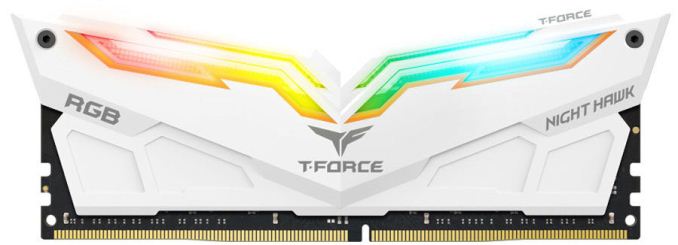Memory Scaling on Ryzen 7 with Team Group's Night Hawk RGB
by Ian Cutress & Gavin Bonshor on September 27, 2017 11:05 AM ESTTeam Group's Night Hawk RGB Memory
16GB of DDR4-3000 CL16 (TF2D416G3000HC16CDC01)
For our testing, Team Group provided us with a dual channel kit from its T-Force Night Hawk RGB range. This is a 2x8 GB kit rated at DDR4-3000 with latency timings of 16-18-18-38. The T-Force Night Hawk DDR4-3000’s are a fairly middle of the road (spec wise) dual channel offering when compared to some of the high-end kits, but the Night Hawk kit comes aims at a much more reasonable balance of price point and performance. With the high-performance kits, the price is paid on the way the memory is binned - with kits like the Night Hawk RGB, there is a small 'RGB tax' over non-RGB mono-color variants, which usually comes in at around $5-$10 depending on the manufacturer. The RGB element is purely for aesthetics, so while on paper and financially it makes less sense to opt for the RGB option over the mono-colored version, our discussions with vendors gave an insight into this market. As far as we were told, RGB sales are growing faster than anyone ever expected - system design customisability is becoming an important consideration of a PC build.
For the memory itself, Team Group has gone with a rather eccentric hawk inspired heatsink design as the brand. The modules end up 1.73”/44mm in height, so for context, the Noctua NH-D14 CPU cooler has a clearance for memory of up to 45mm, so this kit should just about fit.
Under the heat sinks, Team Group has opted to use single sided Samsung B-die ICs. These memory ICs are highly favoured by extreme overclockers for their potential overclockability and frequency scaling, as well as the ability to really tighten the latencies; at very high frequencies and tight latencies, some of the more synthetic tests that competitive overclockers love make a difference, and memory manufacturers use that as a marketing tool when it comes to B-die. That being said, despite sending us a memory kit using B-die, Team Group did say however that in future it could change the ICs in the kits depending on market pricing and availability of such modules. This is disappointing, but not completely unexpected as other companies also do this. Our normal policy applies when this is the case: if this were to occur, we would want the model number would change to reflect this. There are attempts online by competitive overclockers to identify which memory modules use certain ICs, so if one model number had several IC versions, it would be very confusing to organise.

The Team Group T-Force Night Hawk RGB DDR4-3000 kit comes with a global lifetime guarantee in the US, and supports RGB LED customisation. This particular kit is synchronizable with ASUS motherboards via ASUS Aura Sync. The purpose of platforms like Aura Sync is to allow users looking to colour match their existing products through products such as peripherals, motherboards, VGA and even RGB LED strips such as BitFenix’s Alchemy range and virtually all of Cablemod’s current line-up.











65 Comments
View All Comments
notashill - Wednesday, September 27, 2017 - link
There's a new AGESA 1.0.0.6b but AMD has said very little about what changed in it.JocPro - Wednesday, September 27, 2017 - link
According to page 3, how come 2933 MT/s (67 MT/s apart of the rated bandwidth) is *nearest* to the kit's rating, if 3066 MT/s is just 66 MT/s apart of the kit's rating?DanNeely - Wednesday, September 27, 2017 - link
Because rounding. They're 2933.33333.... and 3066.66666..... Both are 66.6666.... off and XMP (which is how the DIMM maker specifies what to do) rounds to the lower one not the higher one.DanNeely - Wednesday, September 27, 2017 - link
In theory anyway. In practice manufacturing variance (not sure if CPU or mobo) means the step size won't be exactly 133.3333.... but rather slightly higher or lower than that value.FreckledTrout - Wednesday, September 27, 2017 - link
For those prices I would rather pick up G Skill Flare x running at 3200Mhz and CAS14 ($190 on newegg).qlum - Wednesday, September 27, 2017 - link
While it is an older lgame it would have been interesting to see fallout 4 included here as it is notorious for its memory scalingOutlander_04 - Wednesday, September 27, 2017 - link
I am curious about the use of such an old graphics card. Surely an nVidia 10xx card, or RX vega was availableLolimaster - Wednesday, September 27, 2017 - link
Come one, people are running 3200 CL14 on Ryzen for many months, why test with a puny CL16.This should also include DDR4 3600-4000 with many brands.
Nagorak - Thursday, September 28, 2017 - link
Few have even managed to get 3600 MHz stable with Ryzen, let alone anything more than that. Even 3466 isn't a given for many boards/processors.CheapSushi - Thursday, September 28, 2017 - link
I think it is time for RAM to go the QDR route (quad data rate) instead for upcoming DDR5. It's already proven and workable in SRAM and GDDR5X (it's QDR despite the name. This would be a MUCH more significant improvement in latency and I/O than the paltry MHz bump DDR5 will do. I think AMD's Zen architecture would benefit and go even further with QDR for next gen.Image of QDR vs DDR: https://upload.wikimedia.org/wikipedia/commons/thu...
Image of QDR vs DDR: http://image.slideserve.com/1303208/qdr-class-vs-d...